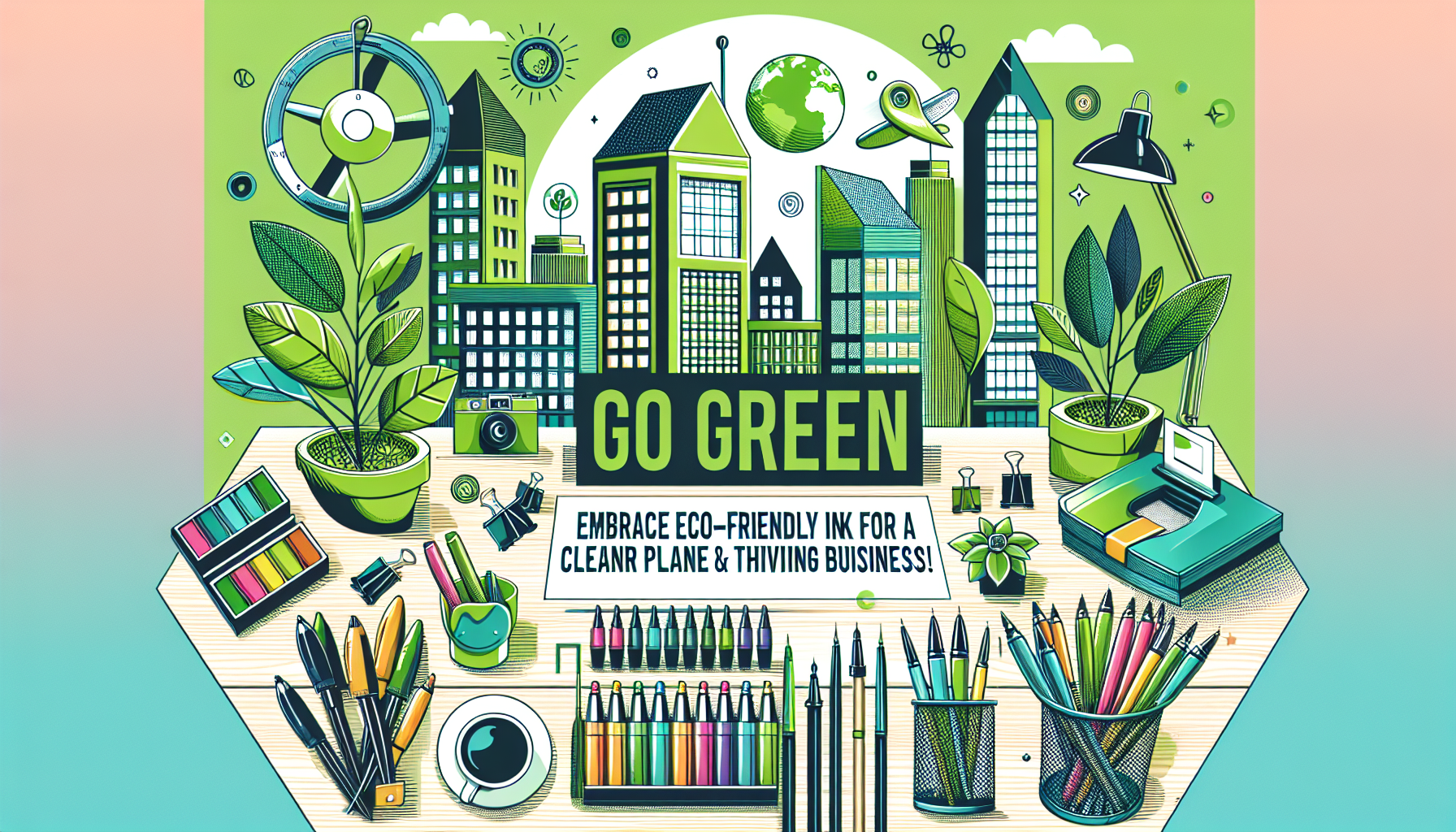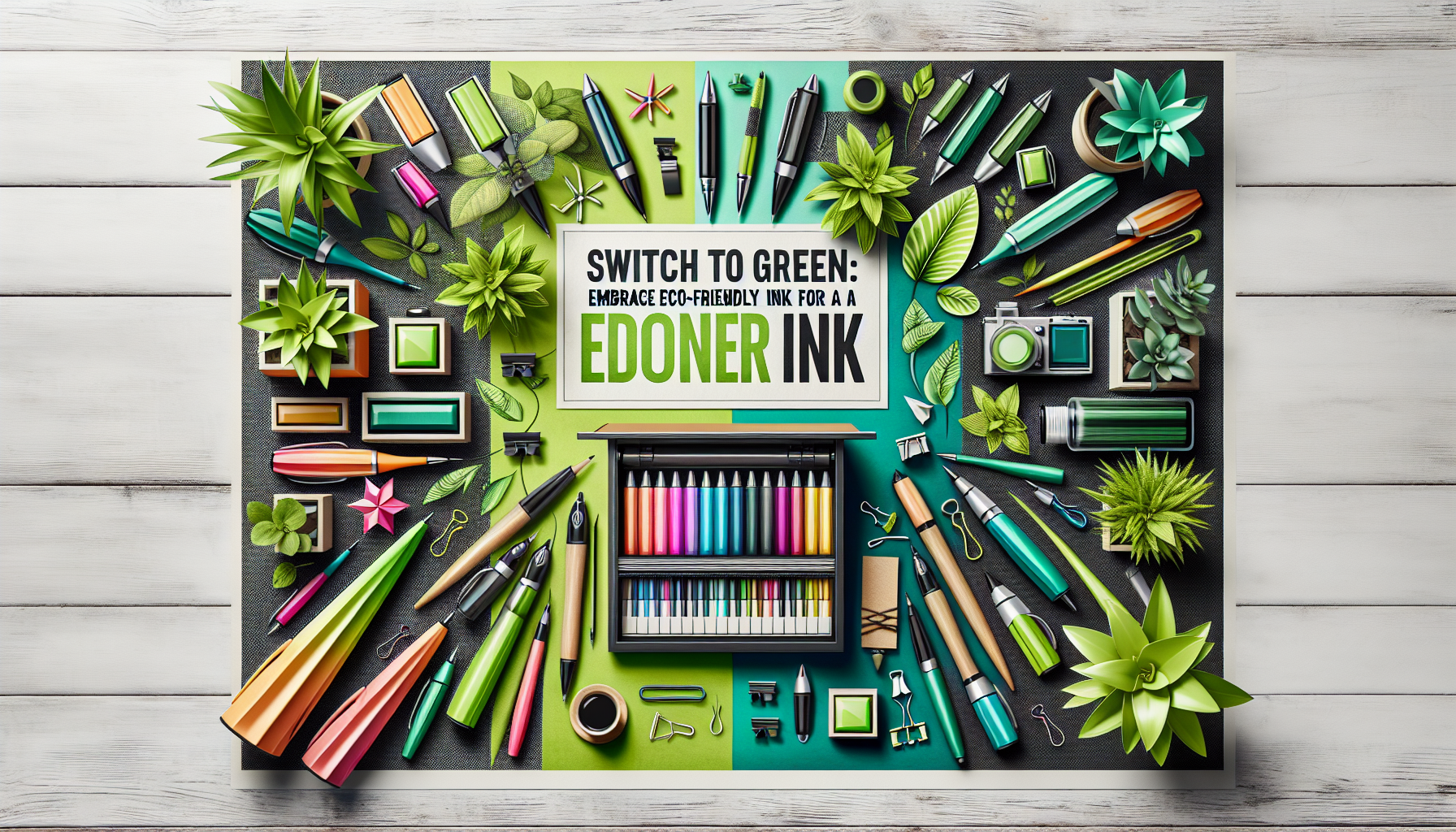Understanding eco-friendly inks
In a world where ecological awareness is growing, it is becoming essential for companies to turn to more environmentally friendly alternatives. Ecological inks are one of these innovative alternatives that reduce the environmental impact of the printing sector, while maintaining optimal quality and efficiency.
Innovation and technology at the service of ecology
Recent technological advances have made it possible to offer more sustainable inks, including a more environmentally friendly method for creatingconductive inks (source). These new inks, in addition to their conductivity, offer an alternative to classic inks rich in volatile compounds and other substances harmful to the environment.
Eco-responsible visual communication
Embracing the use of eco-friendly inks can also help strengthen a company’s brand image. Take the example of Mordelles, whose new ecological visual identity was recently revealed (source). Such an initiative aligns perfectly with the values of sustainability and social responsibility.
Greener alternatives for offset printing
Heidelberg and Siegwerk, for example, are at the forefront in offering new ink technologies more sustainable and environmentally friendly alternatives to conventional UV offset inks, bringing to the market innovative solutions to meet current ecological requirements (Heidelberg, Siegwerk).
100% green shift in the publishing industry
Publishing houses are not left out, like a house in Paris which has carried out a 100% green shift, with emphasis on the paper and ink used for his publications (source).
Remarkable innovations
Innovations such as Living Ink’s algae-based ink, which only reveals itself after a certain period of time, illustrate the creativity of the solutions available when it comes to reduce the ecological footprint of printing (source).
The creative transformation of pollution
In the spirit of circular innovation, an Indian company has taken a step further by converting air pollution in ink, demonstrating that it is possible to take advantage of waste to create useful and environmentally friendly products (source).
Environmental impact and cost reduction
By adopting eco-friendly inks, businesses are not only moving towards an eco-friendly approach, but they can also reduce their costs operations by reducing their ink consumption and extending the lifespan of their printing equipment. Some tips for reducing the environmental impact of printing have been listed (source) and can guide professionals in implementing more responsible practices.
Editors get up to date
L’environmental impact of the book is a growing concern, and more and more publishers are taking concrete measures to get on the ecological page, through choices of less polluting and more sustainable inks and papers (source).
CSR and ecological printing
Finally, the corporate social responsibility (CSR) must also take into account the challenges of ecological printing. Ecological inks are part of this vision of a printing industry that combines performance and preservation of health and the environment (source).
In conclusion, the adoption of ecological inks is an approach that aligns with current environmental and ethical values while providing economic benefits to businesses. It is a strategic choice that allows us to stand out and meet the growing expectations of consumers and partners in terms of sustainable development.
Choose environmentally friendly ink

In a world where preserving our environment is becoming a pressing priority, it is the responsibility of businesses to rethink their consumption and printing habits. Have you ever considered the impact of traditional inks on the environment? This is where the choosing an ecological ink. This seemingly simple action can have a huge impact on reducing your business’s environmental footprint.
The era of green ink
Adopting environmentally friendly ink is a decisive step towards a sustainable future. Ecological inks are formulated from natural and renewable substances, such as vegetable oils, and they avoid the use of volatile solvents which affect our health and our planet. These inks not only reduce indoor air pollution but also reduce dependence on petroleum products. By choosing ecological inks, your company actively contributes to an industry that is less polluting and more concerned with the well-being of future generations.
Ecological printing: a multiple positive impact
The adoption ofecological inks is not limited to environmental protection; it also contributes to a better brand image. Indeed, by opting for greener alternatives, you communicate to your customers and partners your commitment to sustainability. Additionally, initiatives such as printing eco-flyers or the use ofmore eco-friendly packaging, illustrate your efforts in terms of environmental responsibility.
Choose committed suppliers
In the quest for greener printing, the choice of suppliers plays a key role. Identify partners such as Valley Office, which offers eco-friendly ink cartridges, is essential. By selecting suppliers who share your environmental values, you take part in a sustainable supply chain that expands your positive ecological impact.
Technology at the service of ecology
Technological advancements have paved the way for innovative printing solutions, such as printers without cartridges. This equipment, expected to revolutionize the market in 2024, promises to significantly reduce waste linked to printing. Companies can therefore anticipate this revolution by keeping themselves informed about the progress of this technology, in order to adopt these innovative and responsible solutions as quickly as possible.
Involve and raise awareness among employees
A responsible printing strategy also involves raising awareness among your teams of the importance of sustainable practices in the office. Educate your employees about the benefits of eco-friendly printing and encourage them to be proactive in reducing print waste. Encourage them to become agents of change by adopting simple but effective actions to reduce the environmental impact of your printing. This participatory process not only ensures a reduction in your company’s ecological footprint, but also a more conscious and engaged corporate culture.
Conclusion: Embrace a lighter ecological footprint
In summary, choose a ecological ink is not only beneficial for the environment – it is also a powerful way to show that your business is conscious and proactive in the pursuit of a sustainable future. It’s a commitment that resonates with customers and sets your business apart as a forward-thinking and environmentally responsible entity. It’s a commitment that resonates with customers and differentiates your business as a progressive and environmentally responsible entity. Take the initiative today for greener printing that will contribute to the sustainability of our planet.
Selection criteria for eco-responsible ink

The adoption of a ecological ink has become a priority for companies concerned with CSR (Corporate Social Responsibility). It is an approach that is integrated into a global vision ofeco-design and which takes into account the environmental impacts from production to recycling. But how can you make sure you choose ink that is truly environmentally friendly? Here are the essential criteria for an informed selection.
Composition : The first step is to check the composition of the ink. Traditional inks may contain volatile solvents and heavy metals that are harmful to the environment. Opt for water-based inks, natural resins or organic pigments, which minimize pollution and promote better biodegradability.
Ecological label : A good indicator of the environmental quality of an ink is the presence of recognized labels. For example, the Blue Angel or European EcoLabel label, which guarantees that the ink meets strict standards in terms of air emissions and ecological impact.
Performance and quality : Ecological ink must also be efficient to avoid wasting paper and energy due to poor quality printing. So make sure that eco-friendly ink offers print quality comparable to traditional inks. Tests and feedback (like those presented on The Parisian) could guide you.
Compatibility : Make sure the eco-friendly ink is compatible with your professional printers. Inadequacy can lead to technical problems and additional costs, hindering the optimal management of your print workflows.
Supplier commitment : Choose a supplier committed to sustainable practices, preferably based in Belgium to reduce the carbon footprint linked to transport. Consider its cartridge recycling policy as well as after-sales services to ensure responsible product lifecycle management.
There Parisian publishing house mentioned on Sustainable Info perfectly illustrates this approach by positioning itself on a 100% green shift. Its choice of vegetable inks, combined with a waste reduction policy and the use of recycled paper, shows that it is possible to combine performance and environmental preservation.
In the era of ecology and social responsibility, the transition to ecological inks represents a strategic asset for companies. It is an investment in sustainability which strengthens the company’s image among stakeholders aware of the issues of health and environment, as highlighted in the challenges of ecological printing in 2021.
Adopting ecological inks is not only a responsible act, it is also a lever for companies that wish to stand out and affirm their commitment to a greener economy.
The environmental impact of traditional inks

In the current context where the corporate social responsibility (CSR) is becoming an essential criterion of business ethics, adopting sustainable practices is not only beneficial for the environment but also for the company’s image. In the printing sector, this implies awareness of the environmental impact of traditional inks.
Composition and consequences of conventional inks
Traditional inks are primarily composed of petroleum-based solvents and volatile organic compounds (VOC), which can release harmful gases into the atmosphere. These substances not only contribute to air pollution but can also represent a health risk for workers exposed on a regular basis.
Reduction of the ecological footprint thanks to ecological inks
The adoption ofecological inks represents a major step forward in reducing this harmful footprint. These inks are made from renewable materials such as vegetable oils and organic pigments which are, by nature, less damaging to the environment. By choosing ecological inks, companies not only respect the environment but also act in favor of the health of their employees and customers.
Benefits of a transition to ecological printing
Transition to usingecological inks is therefore an important step towards a responsible printing approach. This can result in a significant reduction in energy consumption, reduction of water and air pollution, as well as optimized waste management. This choice is part of a more global CSR policy, illustrating the company’s commitment to sustainable development.
Achieve sustainability goals
Businesses can take concrete steps to achieve their sustainability goals while maintaining print quality. The use ofecological inks is a concrete approach to this transition, responding to the challenges of ecological printing today recognized as central in the entrepreneurial sector.
To learn more about the importance of eco-friendly printing and the options available, a deeper dive can be done by reviewing recent articles and studies disclosing progress and recommendations in this area of CSR.
To conclude, integrate the use ofecological inks in business printing practices is an approach that helps minimize theenvironmental impact traditional inks while being part of a sustainable development strategy. Not only does this demonstrate a commitment to preserving our ecosystem, but it also helps build a reputation as a responsible company attentive to current issues in our society.
Steps towards an ecological transition in printing
In a context where the preservation of the environment has become an undeniable priority, companies, and particularly administrative services, must change the way they operate in order to be part of a sustainable approach. L’plant print stands out as an innovative solution to achieve this, thereby revolutionizing the graphics industry. Here is a guided journey to undertake this essential ecological transition.
Understanding plant printing
L’plant print is based on the use of inks made from renewable raw materials such as vegetable oils, replacing the solvents and mineral oils usually used. This practice, which is particularly notable in Auxerre, embodies not only a healthier alternative for the environment but also for workers in the sector, exposed to fewer harmful volatile organic compounds. Explained in detail in regional publications, the craze for this type of ink demonstrates a desire to reduce the ecological impact of printing activities.
Evaluate the environmental impact of your business
To take the step towards a ecological transition successful in printing, an accurate assessment of your company’s environmental impact is essential. This analysis will make it possible to detect critical points and identify possible improvements. For example, the intensive use of traditional inks may be a significant factor in emissions of volatile compounds and consumption of fossil resources.
Choosing the right partner for responsible printing
The choice of ink and printer supplier is a key factor in your eco-responsible approach. Opt for a partner who advocates ecological values and who is able to offer concrete solutions such as plant printing. Pay attention to their commitments regarding the management of printing flows and the maintenance of professional printers, in order to ensure the longevity of your equipment while reducing your ecological footprint.
Get involved with ecological certifications
The adoption of ecological inks is often accompanied by certifications which guarantee not only the environmental quality of the product but also its effectiveness. So look for inks with recognized ecological labels, which will attest to your commitment to the planet and which will strengthen the image of your company among customers who are increasingly sensitive to ecological issues.
The French press: a model of commitment
The rise of the ecological transition in France is exemplified by the French press, which is largely committed to reducing its environmental impact. By following this example, and integrating ecological printing practices, companies can not only improve their image but also really contribute to preserving the environment.
Assessment and continuous improvement
Once the transition to ecological inks has been initiated, it is crucial to establish regular monitoring. Evaluating the environmental, economic and social benefits will allow you to adjust your strategy and undertake continuous improvements. This includes further waste reduction, cost optimization and continuous improvement of internal processes.
By incorporating these essential steps into your strategy, you will make your company a leading player in the move towards a healthier and more sustainable environment. The transition toeco-friendly printing is not only a beneficial choice for the planet, but also an intelligent strategic decision that aligns with contemporary values and expectations.


Leave a Reply